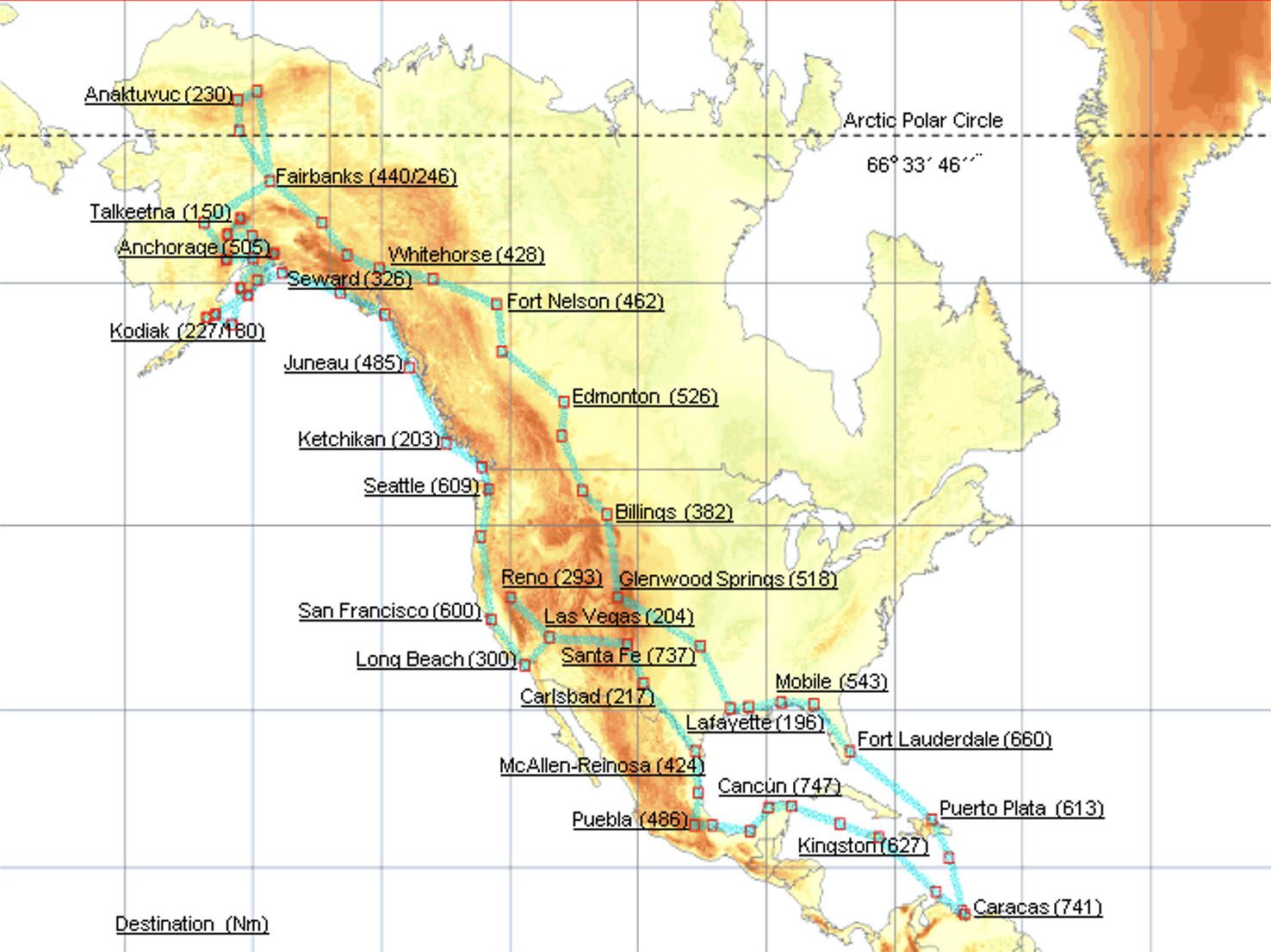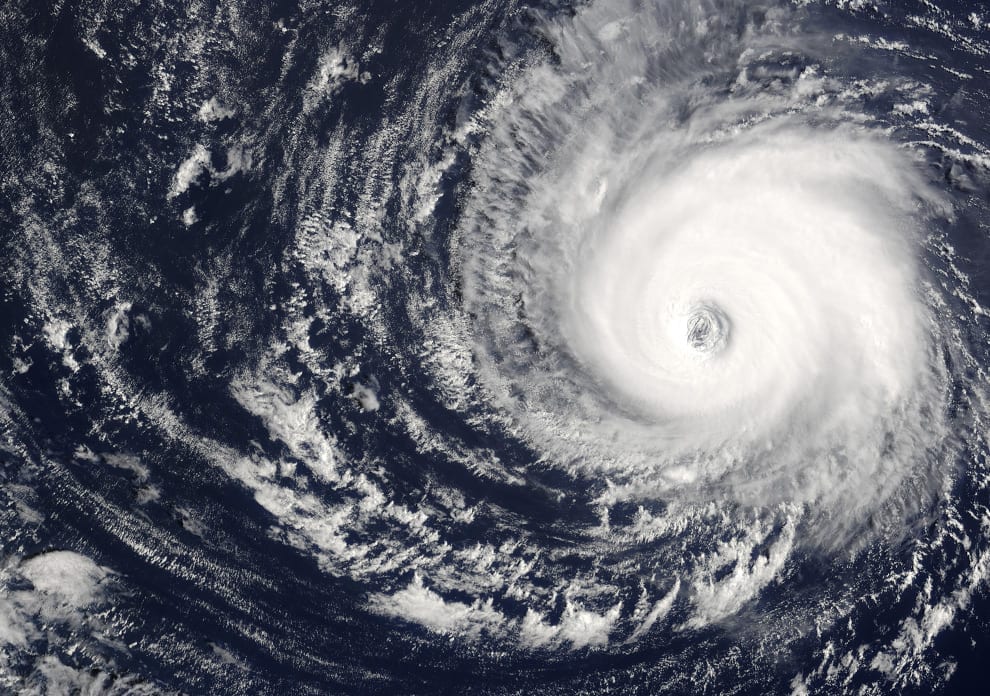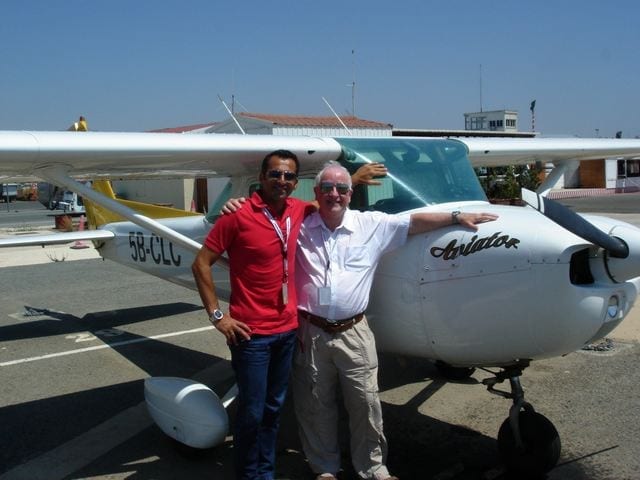|
Getting your Trinity Audio player ready...
|
It all started in May 1998, after we installed factory rebuilt engines in our 1976 Piper Seneca II, YV-850P, with 3,000 hours total time. We also added long range fuel tanks, GAMI injectors, Black Magic automatic waste gates, a JPI engine monitor, a Garmin 150 GPS coupled to an STEC-55 autopilot, LoPresti speed mods, and an Aerox portable oxygen system. The result was an improved Seneca II with a true airspeed of 178 knots at 12,000 ft. at 65% power, and six hours endurance (885 nm range) with a 45 min. IFR reserve.
My partner Mark Dominguez and I asked ourselves where we could go with these new capabilities. Rather jokingly, we said, “why not Alaska?!” After some serious discussions, we decided, “let’s go for it!”
A year later, around 2:30 am on June 30, 1999, we were flying over the Alaskan North Slope at 100 ft., enjoying the astonishing colors of the midnight sun behind us and its reflections on the many lagoons and rivers created as the winter ice melts during spring:
It was quite a long day, with no night for us. At 11:30 am, we arrived at Fairbanks after a 3-hour flight from Whitehorse (CYXY). After lunch and some rest, at 10:30 pm, in broad daylight, we departed northwest to Bettles and turned north, finally landing at 12:15 am at Anaktuvuc Pass (PAKP), an Eskimo settlement above the Arctic Circle. We were welcomed by several kids playing at the airport, surprised by our untimely arrival and who kept staring at what was for them an unusual plane. Their faces lit up when we invited them into the cockpit.
We took off at 2:00 am, flying north of the Brooks Range. A few minutes into the flight, the sun behind us remained low on the horizon, while in front we had a full moon—amazingly beautiful scenery. We landed at Fairbanks a few minutes after sunrise, ending the climactic flight of this first stage of our trip from Venezuela to Alaska.
The second stage started in mid-August, flying Alaska for 17 days, then heading back to Venezuela along the US Pacific Coast, from Seward to Long Beach with several stops. We carried on to Las Vegas, then Reno to watch the famous National Championship Air Races—a must for any pilot. We continued to Santa Fe, Carlsbad, and McAllen, then headed to Mexico and Jamaica, finally arriving in Caracas on September 28, 1999:
This adventure took us across five countries, including landings at 30 cities/towns, and we logged 105 hours over 38 legs; total distance was 16,020 nm. It was, from many perspectives, an unforgettable experience, one we want to share with our fellow pilots.
Planning the trip
A trip of this magnitude requires a lot of preparation to assure a legal, safe, and enjoyable flight.
Our first decision, the possible dates for the trip, was an easy one, since it was dictated by the weather. The best months for flying in Alaska are June, July, and August.
For added safety, we decided that all flights would have two IFR certified pilots, and for each leg we clearly defined the “pilot in command” and the pilot responsible for the flight plan, weight and balance, weather analysis, communications, navigation, etc.
Another safety related decision was to supplement our Venezuelan IFR rating with a US IFR course/rating, which we accomplished in 12 days at American Flyers in Pompano Beach, Florida, including the FAA flight check.
Even though the entire trip can be done VFR, in our experience the safest and easiest way to fly international and/or long trips through complex and congested airspace, is to file IFR flight plans. However, in Alaska most of the flights were VFR, between 500-3500 ft. above the terrain, to view the landscape and avoid any clouds. This also eliminated the risk of ice formation, which in Alaska during summer can be present as low as 4000 ft.
Once the routes were defined, we purchased the required VFR Navigation Charts, IFR Enroute Low and High Altitude charts, Terminal Procedures, the Airport/Facility Directory, and AIM. In 1999 all these documents weighed nearly 25 lbs., which we carefully organized for each leg.
An important issue was to make sure we complied with the minimum insurance requirements of each country. Venezuelan insurance policies normally exclude Alaska. Third party liability coverage in USA, Canada, and Mexico was a minimum of $500,000. In Mexico, insurance policies must be issued by a local company; if not, you risk a $10,000 fine, or worse, confiscation of your plane.
Caracas–Anchorage / June 1999
We started our journey to Alaska on June 18, 1999, landing at Fort Lauderdale (FXE), after a fuel stop at Puerto Plata (MDPP). As always, the Caribbean gifted us with plenty of sunshine, a beautiful variety of blue waters, and… a great surprise! Near Nassau, flying between layers at 12,000 ft, we encountered some precipitation, which in minutes turned into snowflakes. There was a cold front over South Florida and the Bahamas, bringing a lot of precipitation and low ceilings in the area, which required an ILS runway 26 approach down to 400 ft at FXE. This was my first IFR approach in the US—no sweat!
Two days later, we flew to Lafayette to visit our friend and fellow pilot Steve Gruver, owner of a BE-58P and a beautifully restored Piper Cub. Unfortunately, this was the last time we saw Steve and his family, because in 2002 they perished in an accident in New Hampshire.
After postponing our flight one day due to heavy thunderstorms, we departed for Glenwood Springs, Colorado (GWS), with a fuel stop at OKC. During the first leg, with the help of Flight Watch, we managed several thunderstorms, having to deviate about 40 miles east of our route. On the next leg, near the Rocky Mountains, we climbed to the MEA of 16,000 ft. with an extraordinary view of the snow-covered peaks. The landing was an interesting visual approach into GWS.
We left Glenwood Springs two days later, eager to reach Alaska. The selected route was east of the Rocky Mountains, to Billings–Edmonton–Fort Nelson–Whitehorse and finally Fairbanks. During the last leg, we had our first encounter with ice, flying at 12,000 ft. in IMC. After a few minutes of tension due to communication difficulties, and with the help of an airliner, we were cleared to 16,000 ft., above the clouds. OAT was 5 degrees Fahrenheit, and we had no cabin heat! Some newspaper in our shoes helped to keep our feet warm.
As an anecdote, the pilot flying wanted to find out the effects of hypoxia, not using supplemental oxygen. After a few minutes, he was somewhat euphoric, confusing the VHF and VOR frequency knobs, and after finally finding the VS button on the autopilot, he erroneously selected a climb instead of a descent to Fairbanks. A very convincing experience about the need to use oxygen at 12,000 ft. and above.
So, on June 30, 1,999, after 11 legs and 34 hours in the air, we landed in Fairbanks, with a spectacular CAVU day with at least 100 miles visibility.
The day after our flight to Anaktuvuk and the tundra described at the beginning, we flew along the north slope of the Alaska Range, where we had an impressive sight of Mt. Denali, the highest mountain in North America at 20,380 ft. We crossed the Alaska Range at Windy Pass, continued to Beluga Lake and finally headed to Merrill Field in Anchorage, where we left the plane for 45 days, returning to Caracas on a commercial flight.
Flying Alaska / August 1999
We returned to Anchorage on August 21, 1999. Next day, we took YV-850P on a test flight, heading west to the Lake Clark Preserve, where we enjoyed some beautiful views of the Chakachamna Lake and the Triumvirate Glacier, with its unusual black color due to ashes released by several eruptions of nearby volcanoes.
Returning to Anchorage, we used the very limited VFR corridor into Merrill Field (PAMR), which has to be flown below 600 ft. or between 2000 and 3000 ft. This is very congested airspace, since in a 10 nm radius centered in PAMR, you find five other airports: PANC, PALH, PAED, PAFR and CSR.
Once satisfied that YV-850P was in perfect condition, we flew to Kodiak, 220 miles south of Anchorage. There, we hired a Beaver floatplane and headed northwest at 500 ft. to the Katmai National Park, overflying many islands, glaciers, and lakes. We landed in a small lake to watch a family of grizzly bears catch salmon in a river from a nearby glacier. This close encounter with such beautiful and imposing animals in their natural environment was an awesome experience.
The following day, in YV-850P, we flew to the Valley of Ten Thousand Smokes, a remote volcanic area covered in ash from a huge 1912 eruption. We then set course to Seward, flying low over snow-covered mountains, magnificent glaciers, and the Kenai Fjords National Park. This includes the Harding Icefield, its outflowing glaciers, and coastal fjords of incredible beauty.
From Seward, we had to go back to Kodiak, in a foggy day, where I had forgotten my passport and other belongings. Then we flew to Anchorage to pick up Mark´s father, Joe, and his wife, continuing to Talkeetna, to visit the Denali National Park, where the landscape is dominated by the Alaska Range with the highest mountains in Alaska: Mt. Foraker, Mt. Hunter, and Mt. Denali.
Next day, we hired a Cessna 185 equipped with skis and flew low over the Alaska Range and its ridges, canyons, and glaciers, finally landing at the popular base camp for Denali ascents at the beginning of the 44 mile-long Kahiltna Glacier on the southwest slope of Denali. Later, we repeated this staggering flight, full of adrenalin, with YV-850P, circling the Denali summit at 23,000 ft!
Without a doubt, these air adventures were the ultimate flight experience of this stage of our trip, which we celebrated with a most pleasant evening and wonderful view of Mt. Denali, some 60 miles from our hotel.
From Talkeetna we headed to Seward, through the Chugach Mountains, flying low over the Harvard and Columbia Glaciers, two of the more than 100,000 glaciers in Alaska.
We started our return to Venezuela from Seward, a day earlier than we had planned, due to a low pressure system that was expected to bring bad weather for several days along the coast of the Alaska Gulf. On September 3, 1999, we departed for Juneau (PAJN), a 485 nm/3.5-hour flight. This proved to be the most challenging flight of our trip, especially for tropical private pilots used to the nice Caribbean weather all year long. The weather forecast was for clouds over our coastal route, between 5000 and 12,000 ft., with PAJN overcast at 7000 ft., broken at 5000 ft., drizzle and 8 miles visibility. For our alternate, Sitka (PASI), weather was overcast at 8000 ft., broken at 7000 ft., visibility +10 miles.
Our flight plan was initially VFR at 3500 ft. along the coast. As we progressed, clouds got lower, and we were forced to descend to 500 ft. above the water. In order to maintain VFR, we had to fly away from the coast for some 20 mins., climbing to 7000 ft. in VMC. When it became obvious that we could not maintain VFR, we decided to continue IFR, climbing to 15,000 ft. after some communications difficulties with Anchorage Center, and flew about two hours on top the clouds. In the meantime, Juneau weather had deteriorated, reporting overcast 6000 ft., broken at 4000 ft., visibility 6 miles, and light rain.
The approach into PANJ was an LDA runway 08, with a DA of 3200 ft. and MAP 3.2 nm from the threshold. We asked to stay above the clouds as long as possible and to minimize the risk of icing we planned a rapid descent at 1,500 ft./min from our cruise level down to 7000 ft. until SSR, and then 5600 ft. to LYNNS, the IAF. Visual contact of the runway was at about 6 miles and 3600 ft., with an uneventful landing under some tension in the cockpit, I must say, given the marginal weather, surrounding topography, no radar control, and the possible diversion to our alternate.
Next day, we flew to Ketchikan (PAKT) for an overnight stop, to continue to Seattle Tacoma (SEA), a 609 nm, 4.5-hour flight, leaving behind Alaska, very happy with a great number of unforgettable experiences and memories that last forever, and very satisfied for making true a dream flight, as private pilots in a plane with the capabilities of our Seneca II.
From my perspective, after flying 4200 hours in 48 years, this trip from Venezuela to Alaska and back was by far the most special and extraordinary adventure as a private pilot.
- From Venezuela to Alaska and back - November 15, 2021




















What an unforgettable adventure! This would make a wonderful documentary.
Love the story! Sadly, I was never able to experience the GA experience in Venezuela. I am glad the US has the best GA community and system in the world! Thanks, Roberto for the amazing story! Let me know if one day you are around the DFW area!
Robin: indeed, it was an unforgettable experience which we fully enjoyed, first planning the trip, then flying each leg and afterwards, every time we recollect our adventure!!!
Manolo: I am very glad you enjoyed the story. Indeed, flying in the US is fun, easy, with a great and very helpful system. Venezuela is a wonderful country for GA flying, with good weather all year around, and plenty of places to go for a weekend: gorgeous beaches, bays and keys, beautiful plains with many rivers to go fishing, the plateaus of Guayana and its famous Angel Falls, the highest in the world, the Amazon jungle, etc. Unfortunately, nowdays, the system has become very cumbersome and AVGAS is scarse, so GA flying is very limited, hoping for better times. Looking forward to meet you in DFW…
Roberto, what a great adventure!
Chapter 2 has to be your flight to Ecuador, I’m looking forward to it!
Thanks for sharing it with us!
Hi Raul, nice to here from you. I believe, you also have a lot of stories to share after so many years of flying, and still active.
Roberto very nice journey and history. I know many others of yours flights testimony
Fernado: thank you for your comments. I hope to fly with you again…
Hello Roberto,
I love this story! I actually run a nonprofit organization based in WA state (www.hermanosva.org) that benefits a growing number of Venezuelans in the Western part of the country. We use Microsoft Flight Simulator to recreate deliveries of food, medicine, and other necessities in the region and crowdfund our efforts by streaming our journeys on twitch. My community recently voted to have us recreate your journey from Venezuela to Alaska and back in the Seneca. We’d love to have you on the show sometime and/or would appreciate the opportunity to learn more about this tour, the aircraft, etc. Let me know if this would be of interest to you. I’ll check back here in the comments or please feel free to email as well.
I hope to hear from you soon, and hope you and your family are doing well! Saludos!
Nick “ArticTern” Williams